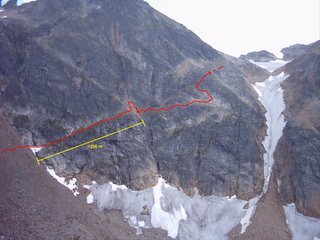Grum's Stories of the Field Part 3
 My apologies to those who fainted while holding their breath waiting for this entry to be posted. And if you hit your head when you fell, then that's really too bad.
My apologies to those who fainted while holding their breath waiting for this entry to be posted. And if you hit your head when you fell, then that's really too bad.I'm probably going to get a cell phone. Unfortunately all the cell companies are money-grubbing bastards with weak mountain coverage and very simple plans which happen to have more fine print than the National Library and Archives of Canada when viewed from 35,000 ft.
Well on with this next episode, The Sky is Falling.

Ok well it wasn't the sky but actually even more frighteningly, the mountain. Or at least bits of it. It was summer 2004, the second time I was a Monashee Mountains field assistant. We had had a very long, very hard day, with some very precarious ledge walking involved (see above pic #1 with my route in red, click for bigger image). This was by far the most dangerous and longest ledge walk ever. It was about 500 m of crampon-less and rope-less scrambling and with a near vertical drop up to a quarter of a vertical kilometre on the right. The grass, where there was grass, was slippy and sloped towards the edge. This induced some totally gut wrenching slip moments, but was generally safe since I had my ice axe hooked deep into any hold it could find. I owe it my life. The danger was not here, though. No it was further on (see pic #2).
In this pic it's the end of the day and we walked in this direction (away from my location) on the scree (loose boulders) under that peak on the left there. The peak is a long way away, meaning that the vertical cliff, looming over the scree, that forms the side of the peak is very very big. We need to climb over it to get back to camp (which is almost directly on the other side of that peak). We eventually found a good safe route further down the hill that is hidden from view in that pic, but not before disaster almost struck.
So we're walking on the scree (which is inherently unstable), and Andy is just a few metres from the cliff face (looking for a way up), while I'm a couple of dozen out finding safer more compacted scree boulders to walk on. We hear a familiar and in this case particularly horrible sound from high above: a sharp, almost hollow crack. The unmistakeable sound of a large falling boulder hitting solid rock. We look up, and it is for a moment still invisible, but then I see it first. It's like slow motion; this (full) backpack sized boulder comes spinning out from up high on the cliff, and at a glance it's headed straight for Andy. I shout, he sees, he jumps, leaving his ice axe where he was standing. He lands awkwardly in the scree, on his backpack and arm, and slides with a small rockfall for a short distance. The boulder lands exactly where he had been standing, and smashes his ice axe to aluminium smithereens. Luckily it did not roll down the hill on top of him, but just pushed some smaller boulders down to where he was scrabbling to get out of their way.
He stood up, his eyes wide, and stared at his hand, on which the little finger was askew. "Ahh! I dislocated my little finger!" he said. He popped it back in. "Ahh!!! I popped it back in!!" he said, apparently quite surprised by this. Then we got the hell out of there, staying well away from the actual face for as long as possible. The climb up was bloody hard for Andy once we found our faulted scree to climb, since he had a busted ice axe and dislocated pinky finger. He made a small splint once we got back to camp and was ok though. Thankfully it was our second last day of fieldwork.
The moral of the story is to be bloody careful when hanging about under cliffs; even if there's nobody up there to be pushing rocks down at you, they can still fall on their own. Actually I have seen, through binoculars, a mountain billy-goat walk up to a large boulder teetering on an edge, put his horns against it, push it over, and lean way out to watch it bounce down the mountain. No joke. Why they do this, what possible benefit it could have for their survival (other than it is fun to watch), completely eludes me.
Next time the last and most horrid episode of my stories of the field series. This was the closest I ever came to dying, or at least serious injury. Don't miss it.
Cheers.


1 Comments:
It seems that billy goats have more in common with humans than one might think.......poor Andy, glad he's OK
10:59 AM, January 18, 2006
Post a Comment
<< Home